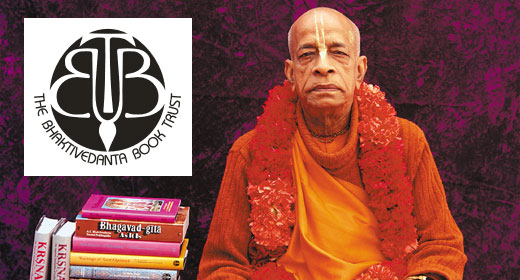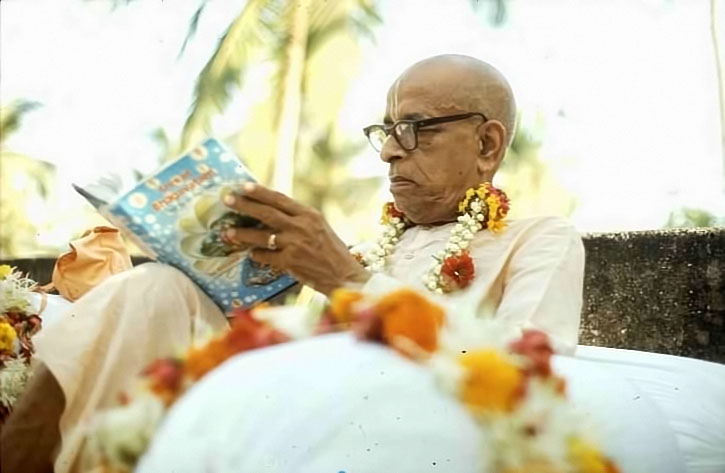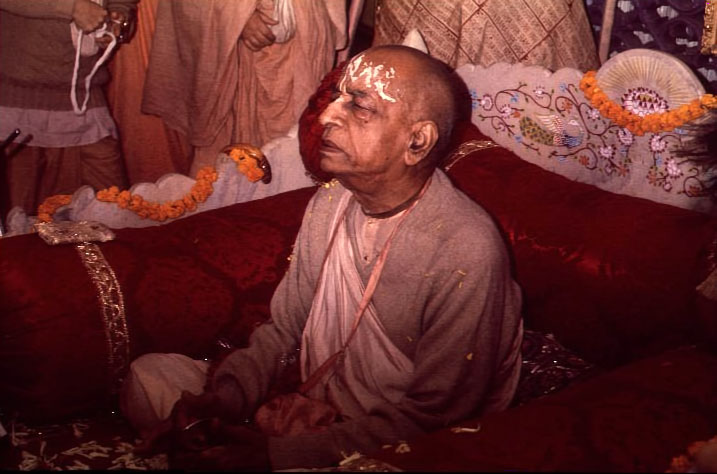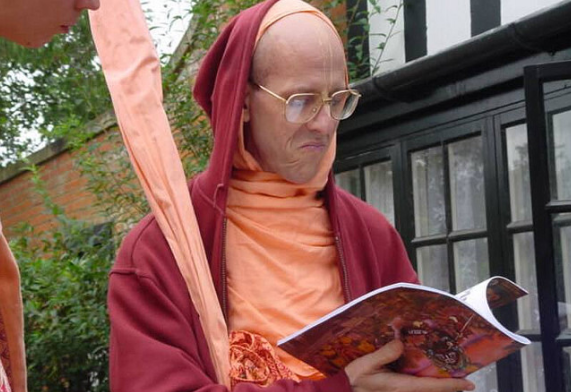A Note About the Second Edition of Bhagavad-gita As It Is
(from page 866 of the “Revised and Enlarged Edition,” 1983 printing.) For the benefit of readers who have become familiar with the first edition of Bhagavad-gita As It Is, a few words about the second edition seem in order. Although in most respects the two editions are the same, the editors of the Bhaktivedanta Book Trust have gone back to the oldest manuscripts in their archives to make this second edition even more faithful to Srila Prabhupada’s original work. Srila Prabhupada finished Bhagavad-gita As It Is in 1967, two years after he came from India to America. The Macmillan Company published an abridged edition in 1968 and the first unabridged edition in 1972. The new American disciples who helped Srila Prabhupada ready the manuscript for publication struggled with several difficulties. Those who transcribed his taped dictation sometimes found his heavily accented English hard to follow and his Sanskrit quotations strange to their ears. The Sanskrit editors were hardly more than beginners in the language. So the English editors had to do their best with a manuscript spotted with gaps and phonetic approximations. Yet their attempt to publish Srila Prabhupada’s work was a success, and Bhagavad-gita As It Is has become the standard edition for scholars and devotees around the world. For this second edition, however, Srila Prabhupada’s disciples had the benefit of having worked with his books for the last fifteen years. The English editors were familiar with his philosophy and language, and the Sanskrit editors were by now accomplished scholars. And now they were able to see their way through perplexities in the manuscript by consulting the same Sanskrit commentaries Srila Prabhupada consulted when writing Bhagavad-gita As It Is. The result is a work of even greater richness and authenticity. The word-for-word Sanskrit-English equivalents now follow more closely the standard of Srila Prabhupada’s other books and are therefore more clear and precise. In places the translations, though already correct, have been revised to come closer to the original Sanskrit and to Srila Prabhupada’s original dictation. In the Bhaktivedanta purports, many passages lost to the original edition have been restored to their places. And Sanskrit quotations whose sources were unnamed in the first edition now appear with full reference to chapter and verse.
Jayadvaita’s Explaination of the Changes to Srila Prabhupada’s Bhagavad-gita As It Is
Bhagavad-gita As It Is Second Edition
Date: 10/25/1982
From: Jayadvaita Swami
To: Senior ISKCON Devotees
Dear Prabhus,
Please accept my most humble obeisances. All glories to Srila Prabhupada! Everyone wants to know, “When will the new unabridged Gita be coming out?” According to the latest I’ve heart, the BBT plans to begin work on the new Bhagavad-gita As It Is right after Gaura Purnima.
The book itself should be available for distribution several months later. I’ve finished revising the purports. The revisions clear up various mistakes and mysteries. (For example, you’ll finally see the last sentence this way in the purport to 2.1: “This realization is made possible when one works without attachment to fruitive results and is situated in the fixed conception of the real self.”)
You’ll also find lots of new material retrieved from the original manuscript, including numerous Sanskrit quotations and even entire paragraphs formerly left out. The Sanskrit department has also carefully gone over the synonyms. (So, for example, the synonym for asat in 17.28 will at last say “false” instead of “falls”.)
And finally the translations. In one sense, the translations are the least important part of the book. Other scholars had already translated the Gita before Srila Prabhupada. (Dr. Radhakrishnan’s translation, Srila Prabhupada said, was basically all right.) And Srila Prabhupada always said that the most important thing was his purports. (He even told the original editor for Bhagavad-gita As It Is that he could have some freedom in editing the translations “to convey a poetic flavor” but warned that he should be careful not to make needless changes in his “personal ecstasies,” his purports.)
On the other hand, in some ways the translations are far more prominent.
For each verse, those one or two sentences stand out alone, inviting scrutiny. They give us our English version of Krsna’s original words.
And of course many devotees memorize these translations verbatim.
Changes made to the translations stand out. So I want to be especially cautious in making them.
Specifically, I want the senior devotees in ISKCON to have a chance to examine all the changes before the book comes out. I want you to see the changes, to understand what’s behind them, to have a chance to raise questions or make suggestions about them–and, finally, to satisfy yourself that the changes are prudent, legitimate, and worthwhile.
So here they are–all the changes I have proposed for the translations in the new edition.
Some of them, you’ll see, are quite small–a matter of a comma, a colon, or a semicolon. Others are major. And all of them are here.
For most of the revisions, I’ve given only those portions of the verse where the changes occur. This lets you spot the changes quickly. (But you have to compare these sheets to the book itself to see how the revised verse reads.)
Now, you have a right to ask, how and why were these changes made? First of all, why?
Several reasons: Sometimes (most often) to make the text more faithful to what Srila Prabhupada originally said. Sometimes to make it closer to the Sanskrit (coming closer to Srila Prabhupada’s original manuscript often made this happen automatically). And sometimes it was merely a question of grammar.
How did we go about the work?
I went through every page of the oldest manuscript we have. (For the first five or six chapters these are Srila Prabhupada’s original typed pages, for the middle chapters they’re the original transcripts of his tapes, and for the last chapters they’re the old retyped manuscripts from which the present book was edited.)
Comparing each verse in the book with the text of the manuscript, I made only those changes that to me seemed worthwhile. I tried to be conservative and not make needless changes. At the same time, I kept in mind that whatever changes we are to make we should make now, so that the book will never need to be revised again.
Gopiparanadhana Prabhu of the BBT Sanskrit Department also carefully examined each verse and made his suggestions, which I consulted throughout.
Whenever difficult questions arose, Gopiparanadhana and I met to consider them, and we consulted the original books Srila Prabhupada consulted when he wrote Bhagavad-gita As It Is–the Bengali translations and commentaries by Srila Bhaktivinoda Thakura and Srila Baladeva Vidyabhusana.
To give you further insight into the reasons for some of the changes we made, here are some examples.
First, here are some of the verses I revised to make them closer to Srila Prabhupada’s original manuscript: 2.1-7, 2.13, 2.16, 2.20, 2.24, 2.26-27, 2.34, 2.45-46, 2.48-49, 2.51, 2.55, 2.65-66, 3.1, 3.5, 3.7, 3.10-12, 3.16-17, 3.23-24, 3.30, 3.32, 3.34, 4.15, 4.35, 5.24, 7.29-30.
And many others.
In some of the later chapters (especially 17 and 18), the abridged edition gives translations closer to the original manuscript than the unabridged does. So I’ve preferred those translations from the abridged edition.
As you examine the translations, keep in mind that in some places I have also revised the synonyms or purport, or both. (For example, 9.6. The revised version more closely follows the original manuscript. And note, in the purport, that “Space is not beyond the sky” is nonsense.)
For some verses we added extra words or sentences to translate Sanskrit words left untranslated in the original manuscript. (This is something Srila Prabhupada, while present, approved of our doing routinely on Srimad-Bhagavatam.)
For example:
- 1.35 nihatya dhartarastran nah ka pritih syaj janardana –-”O Janardana, what pleasure will we derive from killing the sons of Dhrtarastra?”
- 7.6 etad yonini bhutani sarvanity upadharaya – “All created beings have their source in these two natures.”
- 9.34 bhava mad bhaktah – “Become My devotee” (!)
- 18.54 prasannatma – “He becomes fully joyful.”
For some verses, the original editor (new at the job and with no access to a Sanskrit department) misunderstood what Srila Prabhupada intended to say. When unsure which way to go, the editor sometimes made a wrong turn.
For example:
- 1.4 (Yuyudhana and the others are the great fighters equal to Bhima and Arjuna.)
- 1.18 (The son of Subhadra was “great-armed,” not “greatly armed.”)
- 4.26-30 (I had never been able to figure out these verses. Have they ever been clear to you?)
- 10.12-13 (The editor tried his best to make the translation fit the Sanskrit–but without knowing Sanskrit.)
In Chapter 11, the manuscripts were difficult to understand. Without knowing Sanskrit, the editor had a hard time figuring out the translations and matching them to the synonyms. So this chapter has the most extensive revisions.
Sometimes (very cautiously) we changed the text on the grounds of the Sanskrit alone. (This helps considerably when you try to study the translation with the synonyms.)
Examples:
- 2.10 (The revised translation loses no meaning, and it clears up the puzzle in the synonyms.)
- 15.14 (Again, the English wasn’t clear but the Sanskrit is: It’s the fire, not the air, that digests food.)
Sometimes the person who transcribed the tape heard things wrong or scrambled things. For example:
- 10.12 (There’s no “all-pervading beauty” here. Perhaps what the typist heard was vibhum.)
- 11.5 (There’s no “sea” in this verse. Only pasya–”Just see!”)
- 14.17 (What comes from passion, Krsna says here, is not grief but greed.)
Some verses had problems in grammar (like 2.17, 2.22 , 4.3). And here’s something really strange:
In the original manuscript, Chapter 8 text 18 was missing. So the Sanskrit editor supplied the synonyms. But the English editor thought that the translation and purport he saw for text 19 belonged to text 18.
So he put them for text 18 and put in a new translation for 19. (So all this time, our book has had the translation and purport for text 19 in the wrong place, we’ve had two translations for text 19, and text 18 had been missing!)
In summary:
Now you have some background for the revisions you now hold in your hands. A GBC committee has reviewed the translations, and the whole GBC will have a chance to consider them one last time in March before the book goes to press.
Please examine these revisions carefully. And if you feel you want to say something about them–if you have any questions, suggestions or opinions about any or all of them–please get in touch with me, through the mail or in person, at my address in Philadelphia. (Even if I’m traveling, you can get in touch with me through the BTG offices in Philly.)
This new Gita (along with its translations in other languages) will be the main book our movement will be preaching from for whatever time we have left in this yuga.
Now is the time to make sure we are presenting Srila Prabhupada’s Bhagavad-gita As It Is in the most authoritative fully satisfying way.
And I invite you now to contribute whatever thoughts you have on this work.
Hare Krsna.
Hoping this finds you in good health.
Your servant,
Jayadvaita Swami
Date: July 1986
From: Jayadvaita Swami
To: Amogha Lila
His Grace Sriman Amogha Lila Dasa, 188 New Chetty Street, Colombo 13, Sri Lanka
ISKCON Padayatra Sankirtan Bhavan, P.O. Jhusi Allahabad, 221 506, U.P., India
[July 1986]
Dear Amogha Lila Prabhu,
Please accept my most humble obeisances. All glories to Srila Prabhupada.
I am in due receipt of your letter, dispatched June 21, and have noted the contents carefully.
You’ve heard strongly expressed objections to the second edition of Bhagavad-gita As It Is, and you’ve written to me because you want to investigate the matter more fully.
I’ve been silent about this, so as not to overindulge in the animalistic propensity of defending. But since you’ve raised good questions, it’s my duty to answer.
First: To my knowledge, Srila Prabhupada never asked us to re-edit the book.
As you know, and as we kept in mind while doing the work, Srila Prabhupada staunchly opposed needless changes.
You write that Kirtanananda Maharaja told you I regretted having done the editing and that if I’d known of his feelings or read his paper commenting on the work I wouldn’t have done it at all.
This is a misunderstanding. What I regret is that I didn’t have the benefit of Kirtanananda Maharaja’s comments while the work was still going on, long before the book was published.
In fact, a full year before the book went to press, I sent Kirtanananda Maharaja a letter telling exactly what I was doing and why. I included a copy of every change I had made in the translations. And I earnestly asked for any comments, questions, or suggestions he might have. To save us from exactly the kind of controversy he has now raised, the letter pleaded that doubts be voiced then, while time was ample and the work was still on our desks.
I sent the same letter not only to Kirtanananda Maharaja but also to every other member of the GBC, most English-speaking ISKCON sannyasis, various other senior ISKCON devotees, and every ISKCON temple president in the English-speaking world.
What I regret, therefore, is that those who now speak out were silent when their wisdom was sought.
I do *not,* however, regret undertaking the task of revision, and now I shall tell you why.
As mentioned in the “Note about the Second Edition” that appears in the book, the editors of the first edition are to be praised. They did a fine job of making a tough manuscript ready to print.
They also, however, made lots of omissions, goofs, and blunders, which I see no need to immortalize in print.
I suppose that what disturbs some devotees most is the changes in the translations. As you know, Srila Prabhupada considered the translations less important, and so do I. For me the more important revisions, therefore, are the ones in the purports. Of these there are easily several hundred.
To answer your letter, I spent an hour or so going through the book to pull out some samples for you. To examine them you should have before you a copy of both editions–the old one and the new. To look at the samples carefully may take you a couple of hours. But it’s the best way I know to answer your questions, and I’m sure you’ll find your time well spent.
Here goes.
There are different categories of corrections.
- SIMPLE BOO-BOO?SFor example, simple obvious spelling errors. Who would be willing to insist that the reference to the province of “Behar” (old edition, page 185) should not be changed to “Bihar”?Chapter 16, verses 1-3, purport. Read the first line of the last paragraph in the old edition. Despite what the purport says, the transcendental qualities add up to 26, not 16. Someone typed a “1″ instead of a “2,” so the count is off by 10.
- MISSING EVIDENCEHere’s something more serious. In the old edition, dozens and dozens of Srila Prabhupada’s Sanskrit quotations–Vedic evidence, sastra-pramana–have simply been edited out.In the Introduction of the new edition, for example, here are some of the quotations you’ll find restored:
- pg. 8: mayadhyaksena prakrti, etc.
- pg. 12: muktir hitva anyatha rupam, etc.
- pg. 14: parasya saktir vividhaiva sruyate
- pg. 17: yad gatva na nivartante, etc.
- pg. 26: visnu-sakti para prokta, etc.
- pg. 28: kirtaniyah sada harih
- pg. 30: tad vijnanartham, etc.
These are Srila Prabhupada’s words. The Introduction is still available on tape, and you can hear them for yourself.
And if you want something bigger, how about this: The old edition, on page 27, adds a verse Srila Prabhupada didn’t speak (nehabhikrama-naso ‘sti) and then leaves out every one of the renowned verses from the Gita-mahatmya with which Srila Prabhupada’s original Introduction concludes.
I’m not even slightly sorry that these verses have now been restored.
Throughout the new edition the editors have restored dozens and dozens of Sanskrit quotations, large and small, the old edition simply scratched out.
For a few more examples, you can look at the purports to the following verses: 2.43, 2.56 (two quotations), 2.63, 9.4, 9.6 (three quotations), 9.7, 9.9, 9.11 (new edition, pg. 469–three quotations), 9.12, 10.15, 11.43 (three quotations). In 11.54, no fewer than eight quotations have been restored.
And there are dozens and dozens more. The verses you now see are not editorial speculations, guesses, helpful additions or any other such nonsense. They are the very words of our acarya, jumbled by typists and scratched out by editors in the 1960′s, now restored to their place in Srila Prabhupada’s book.
- POINTS WITHOUT PINSHere’s another, related sort of omission. Sometimes when Srila Prabhupada comments on a Sanskrit word, the editors have kept the comments but edited out the word. For example see the references to avasam (9.8) and udasina-vat (9.9). Or, at the end of the purport to 13.12: “The beginning of knowledge, therefore, is amanitva, humility.” To me, these references add immensely to the value of Srila Prabhupada’s purports. With these references, we can clearly see how Srila Prabhupada’s comments directly illuminate specific words of the verse.And, again, these are not editorial whimsies–they’re Srila Prabhupada’s original words.
- GLOSSES TOTALLY LOSTSometimes Srila Prabhupada’s comments on a word are *entirely* left out.For example, see his comments on the word na (11.54) and tad-arthiyam (17.27). And these are but examples–there are more.
- SANSKRIT SLIPSSometimes the Sanskriteditors just goofed.
- Example: In 7.18, the Sanskrit quoted in the purport doesn’t match the English translation that follows it. Why? Because the Sanskrit editor supplied the wrong Sanskrit verse. (If you check in Ninth Canto, you’ll see for yourself.) The new edition has it right.
- 7.25. A tired typist or sleepy English editor may have helped screw this one up. The prayer the old edition attributes to Queen Kunti was never spoken by Kunti at all. It’s from the Isopanisad! The new edition follows the original manuscript and sets things right.
- 9.29. The Sanskrit editor guessed which verse to put in–and guessed wrong. The correction is obvious.
- 10.4-5. Is bhayam (old edition, pg. 498) really the word for “fearlessness”?
- 13.15. Sarvatah pani-padam is not from the Svetasvatara Upanisad at all. It’s from the previous verse of the Gita. When the mistake is corrected, you get the brilliant Bhaktivedanta purport of the famous, often misused verse apani-pado javano grahita..
- MANGLED MEANINGSSometimes the inexperienced editors just misunderstood the meaning of a Sanskrit verse.Example (a small one). 5.2. Aside from being a pretty tough sentence to read, the old editing of Srila Rupa Gosvami’s verse scrambles the meaning. The verse doesn’t mean that things related to Krsna, “though they are material,” should not be renounced. The point is that because they’re related to Krsna, they’re not material at all. *That’s* why giving them up, as the Mayavadis do, is dry renunciation.
- GENERAL BLUNDERSThen there’s what you might call good old-fashioned screw-ups.
- 2.1. Have you ever had to explain the last sentence of this purport?
“This realization is made possible by working with the fruitive being situated in the fixed conception of the self.” It’s just an editorial mistake, and it doesn’t make a damn bit of sense. - 2.43. In the last paragraph, what are the “four monthly penances?” It should be “four-month penances” (caturmasya).
- 3.35. In the old edition, look at the second sentence of the purport.
- >How often we’ve heard devotees insist that their prescribed duties must “complement their psychophysical condition.” That may be a good idea.
But look in the new book and see what Srila Prabhupada actually said. - 7.15. The old purport (bottom of page 383) talks about “the swine who eat the soil.” I always thought that strange. Do hogs really eat soil?
What the original text says is “the hogs who eat the *night* soil.” But some editor put a question mark next to “night,” and out it went. What in the world is “night soil”?
Srila Prabhupada knew–it’s a polite name for that good old stuff we all know hogs love to eat. - 7.15. Two sentences later, a typist has left out a line. If you want to find out what Srila Prabhupada said the foolish worker will untiringly continue to hear of, you have to look in the new edition.
- 10.27. They once took a “sea journey.” Hardly. Our old friend Neal the typist, the college kid who walked into 26 Second Avenue and volunteered to type, simply heard things wrong. It was “sea churning.” But back in the old days in the storefront, no one knew the real story.
- 10.29. A “planet of trees”? Fa-aar out! But if the Swami says so, it must be right. Sorry, boys. Srila Prabhupada never said so. It’s Neal the typist again. It’s a planet of ancestors (pitas), or pitrs (pronounced “pi-trees”).
- 10.35. Where has the Lord “already explained” that the Sama-veda is “rich with beautiful songs”? Ask Neal the typist. Or else look in the new book and read things right.
- 13.2. In the old edition (page 621) you’ll read “Sometimes we understand that I am happy, I am mad, I am a woman, I am a dog, I am a cat; these are the knowers.” This is straight-out nonsense. It’s not right, it’s not sacred, and it’s not the words of my spiritual master.
- 15.2. Is the old second paragraph of this purport supposed to stay screwed up and incomprehensible forever?
- 18.31-32. Back in the 60′s, the editors somehow changed the word “ignorance” to “passion” and put the purport in the wrong place. Should it stay there?
- 2.1. Have you ever had to explain the last sentence of this purport?
- TOO HELPFULIt’s the job of the editor to try to help the reader. But sometimes an editor can be too helpful.
- Example: 5.28. In the old second paragraph you’ll find a reference to the pratyahara (breathing) process. On the manuscript you can clearly see that the editor, for the benefit of readers new to yoga, has penned in the parenthetical word “breathing.” But pratyahara is not the breathing process at all–it’s the process of withdrawing the senses from their objects. The breathing process is pranayama. Should this goof be granted sanctity merely for its presence on the page?
- 15.2. “The Gandharvas (fairies).” The editor is being helpful again. But is Narada Muni really a “fairy”?
9. THE RED-PENNED PURPORT
When our editors back in the 60′s came to a passage too hard for them to figure out, they did what was expedient–crossed it out and kept going.
Sometimes it was just a few words, sometimes a sentence or a few sentences, sometimes a whole paragraph.
Sometimes, while trying to prune a paragraph, they cut off valuable fruits and flowers. Sometimes they seem to have thought that Srila Prabhupada was being too heavy. Or sometimes a passage just got inadvertently left out.
Examples:
- 8.11. The old edition loses the first two sentences of the purport.
- 8.6, 8.13, 8.14, 8.19. When Srila Prabhupada spoke the whole mahamantra, the typist often just typed some shortcut, like “HK etc.” The new edition restores the full mantra: Hare Krsna, Hare Krsna, Krsna Krsna, Hare Hare/ Hare Rama, Hare Rama, Rama Rama, Hare Hare. Just see how in this chapter–”Attaining the Supreme”–Srila Prabhupada repeatedly emphasizes the chanting of these 16 holy names.
- 8.28. In the new edition, start reading on page 445, from “The words idam viditva…” and go on till the purport ends. Just see all that has been restored. And appreciate, especially, Srila Prabhupada’s beautiful exposition of how Krsna consciousness grows, from sraddha up to prema.
- 9.26. The first edition loses the whole first paragraph.
- 11.52. In the new edition, page 599, on the last few lines of the page, the fool who offers respect only to the impersonal “something” within Krsna finally gets what he deserves–Srila Prabhupada’s boot in his face.
- 13.5. Srila Prabhupada’s gloss on chandobhih has returned to the page, the next paragraph now makes proper sense, and the last paragraph has been recovered.
- 13.19. Two whole paragraphs lost! For me, Srila Prabhupada’s summary of verses 6 through 18 opened up a new understanding of a chapter that had long perplexed me.
- 16.7. The history of religious editing is not without its humor. Srila Prabhupada’s manuscript clearly says, “One should always be careful to keep his body clean by bathing, brushing teeth, shaving, changing clothes, etc.”
But back in the 60′s, we kept our beards–and trimmed off the word shaving.
You’ve now had a glimpse of the hundreds of omissions and mistakes in the first edition of Bhagavad-gita As It Is. Should what was lost have stayed permanently lost? Should what was screwed up in the 1960′s have stayed screwed up forever? I leave it to you to decide.
One final point. The first edition of Bhagavad-gita As It Is not only preserved errors and omissions but actually *multiplied* them when the book was translated into other languages. What does a translator do with something like “the fruitive being situated in the fixed conception of the self?” A translator faced with a passage that seems wrong or doesn’t make sense does just what the English editors did in the 1960′s–he leaves it contradictory or confusing, he guesses and speculates, or he scratches it out.
If you’d like any more information about the second edition of Bhagavad-gita As It Is, please feel free to ask.
I’m grateful you’ve taken the care to inquire.
Since both Sridhara Maharaja in Bombay and Ravindra Svarupa Prabhu have asked me for similar information, I’m sending copies of this letter to them.
Mail can reach me here at Jhusi up to September 25. Then I’ll go to Bombay to renew my visa. Padayatra will be starting by then, and our mailing address will be c/o ISKCON Delhi.
Hoping this finds you in good health and a joyful mood,
Your servant,
Jayadvaita Swami













